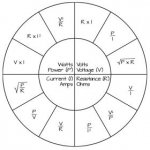In an "Ohm's Wheel", then Ingineur is correct, albeit the question was poorly worded because the entire concept is not that simple. So without context it can be misleading. These Ohm's Wheel diagrams are basically assuming purely resistive loads, not inductive.
View attachment 17949
This of course is also just single phase, hence the addition of the 1.732 factor for 3 phase equations.
If you want to impress your instructor though, point out the fact that the question, as worded, is making an assumption about the load being purely resistive based on facts not in evidence.



